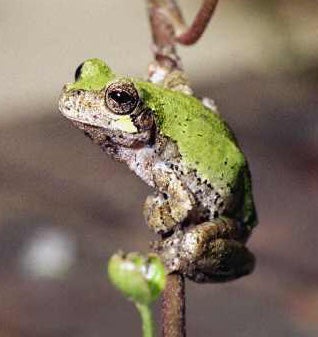SCIENTIFIC NAME:
Hyla avivoca
STATUS:
Common in Coastal Plain to which it is apparently restricted. If valid, one unverified record from St. Clair county in Ridge and Valley ecoregion would represent a northern disjunct population. Lowest Conservation Concern.
DESCRIPTION:
The bird-voiced treefrog is a small slender treefrog with adults ranging from 1 1/8 inches – 1 3/4 inches in length. However, this species is dimorphic, which means females are generally larger in size than males. The dorsal, or back, coloring is generally gray, brown, or green. Like many treefrogs this may change with moisture, background coloration, fluctuating temperatures, and seasonal activity. The skin of the bird-voiced treefrog will be warty with one or more dark blotches on its back. It also has light white spots with black borders below each eye. The bird-voiced treefrog has large toe pads with adhesive, or sticky, disks on the tips of their toes. The hidden surfaces of the thighs usually range from light green to white with dark bars on their hind legs.
The bird-voiced treefrog bears a strong resemblance to the gray treefrog and cope’s gray treefrog. Both species of gray treefrogs are similar in types of habitat used and have ranges that overlap the bird-voiced treefrog. However, there are some key characteristics that can be very helpful in distinguishing them. The bird-voiced treefrog is generally smaller and more slender than both species of gray treefrogs. The bird-voiced treefrog also has a divided pustule (small elevation of skin) at the base of the fourth fingers on each hand. However, in both gray treefrogs, this pustule remains undivided. In both species of gray treefrogs, the hidden surfaces range from yellow to golden orange; while they remain light green or white on the bird-voiced treefrog. The last, and probably most evident and entertaining characteristic, is the call types. The bird-voiced treefrog’s call is a series of piping, bird-like whistles, which occur in rapid succession. The gray treefrog’s call consists of a long repeated musical trill. While the call of the cope’s gray treefrog is a short repeated buzzing trill.
DISTRIBUTION:
Bird-voiced treefrogs are found throughout the southeastern United States. They range from extreme southern Illinois south through Louisiana. They are also found in central and south Alabama, extending as far south as the Florida panhandle. Additionally they are found in South Carolina and throughout central Georgia.
HABITAT AND FEEDING HABITS:
Bird-voiced treefrogs are residents of wooded swamps, river valleys, beaver ponds, and lake shores with flooded vegetation. They are a highly arboreal species climbing high into trees such as tupelo, bald cypress, and birch. Bird-voiced treefrogs are opportunistic feeders. Their diet consists mainly of spiders and small insects. Being arboreal and nocturnal they will forage primarily in trees at night time.
LIFE HISTORY:
Bird-voiced treefrogs primarily breed from April to July. Males will perch on stems or limbs 2 to 8 feet high, near or above water to perform their mating calls. Preferred breeding sites are brush edged semi-permanent to permanent pools and brush edged shores of larger ponds. Females lay packets of 6 to 15 eggs in shallow water; with an average total production of 500 to 650 eggs. Tadpoles will hatch within a few days and develop into adults within a month. Their transform size is approximately one-half inch (1.3 cm). Breeding tends to be increased with heavy rains. Bird-voiced treefrog populations are classified as threatened in their northernmost range. In Alabama populations remain stable with low conservation concern.
REFERENCES:
Conant, Roger. A Field Guide to Reptiles and Amphibians of Eastern and Central North America. 2nd edition ed. Houghton Mifflin Company Boston, 1958, 1975.
Short. Lester et al. Harper and Row’s Complete Guide to North American Wildlife. Eastern Edition. New York: Harper and Row, 1981.
Underwood, J. 2003. “Hyla avivoca” (On-line), Animal Diversity Web. Accessed January 21, 2009 at https://animaldiversity.org/accounts/Hyla_avivoca/.
University of Georgia, Frogs and Toads of Georgia and South Carolina.
https://srelherp.uga.edu/frogs-and-toads/bird-voiced-treefrog/
AUTHOR: Barry Baird, Wildlife Biologist, Wildlife and Freshwater Fisheries Division.






